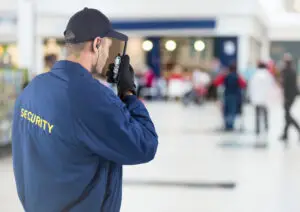Table of Contents
Healthcare facilities are hubs of healing, where patients and their families seek comfort and care during challenging times. However, hospitals, clinics, and health centers also face unique security challenges that demand specialized solutions.
Unlike most business settings, healthcare centers are often open 24/7, welcoming a large number of visitors, patients, and staff members daily, each with diverse needs and situations. This open-door approach is necessary for the functioning of healthcare, but it also makes these places vulnerable to security risks.
From patient safety and visitor control to protecting sensitive information, the security needs in healthcare settings are layered and complex. The healthcare environment demands not only a responsive security approach but one that is proactive, compassionate, and highly professional.
This blog will explore the critical aspects of security tailored to health providers, with practical strategies to protect what matters most—people, data, and resources.
Part A – The Core Security Challenges in Healthcare Facilities

Patient and Staff Safety – Hospitals and clinics often host people experiencing high-stress situations, sometimes leading to unpredictable behaviors. This environment can result in increased risks for staff and patients alike, particularly in high-tension areas like emergency rooms and mental health facilities. Protecting these individuals requires not only physical security but also personnel trained in de-escalation techniques and situational awareness.
Data and Privacy Protection – Healthcare providers handle sensitive personal health information (PHI) daily. This data is protected under HIPAA (Health Insurance Portability and Accountability Act), and unauthorized access can have severe legal consequences. Ensuring both physical and digital data security is crucial, especially as cyber threats evolve.
Control Over Access and Visitor Management – Unlike other sectors, healthcare facilities need to remain accessible to patients and visitors, sometimes even after regular business hours. Managing visitor flow, preventing unauthorized entry, and ensuring that only the right people have access to restricted areas are all essential tasks that fall under security’s responsibility in a healthcare environment.
Emergency Preparedness and Response – In healthcare, emergencies can range from patient-related incidents to natural disasters or even violent intrusions. A comprehensive emergency response plan ensures that security teams, healthcare providers, and support staff know exactly what to do in a crisis, which is critical for minimizing harm and maintaining operational continuity.
Asset Protection – Medical equipment, pharmaceutical supplies, and even patient belongings are valuable and need protection. The accessibility of healthcare facilities makes them vulnerable to theft, requiring effective surveillance and monitoring.
Part B – Building an Effective Security Framework for Healthcare Providers

A healthcare security program must encompass both people-focused strategies and physical security measures. Here’s how to structure an effective approach:
1. Prioritize Training and Personnel Readiness
At ARDENT Protection, every officer undergoes rigorous training tailored to the healthcare environment. This includes:
- De-escalation Training: Especially important in emergency settings where emotions often run high, this training helps officers manage and reduce tensions without escalation.
- HIPAA and Confidentiality Education: Officers learn the importance of patient privacy and the legal standards required to protect it.
- Crisis Intervention Skills: Training on handling mental health crises, substance abuse cases, and patient outbursts equips officers to respond appropriately, protecting everyone involved.
2. Advanced Access Control Systems
Given that healthcare facilities often operate round-the-clock, controlling access becomes essential to prevent unauthorized entry and ensure the safety of patients and staff. Effective access control can include:
- ID Badges and Visitor Passes: Implement badge systems to easily identify staff, patients, and visitors. In high-security areas, require biometric or keycard access.
- Controlled Access to Sensitive Areas: Pharmacies, labs, and patient records require restricted access to authorized personnel only, helping protect both physical assets and sensitive information.
- Visitor Registration and Escort Policies: Visitors should be required to check in, especially after hours, and escorted when entering sensitive or restricted areas.
3. Surveillance and Monitoring Systems
Security cameras are crucial in healthcare facilities to monitor high-traffic areas, emergency entrances, and parking lots. Surveillance systems can:
- Enhance Incident Response: Security personnel can monitor footage in real time, allowing for swift action when necessary.
- Act as a Deterrent: The presence of cameras helps deter potential intruders or internal threats.
- Aid in Investigations: Recorded footage provides valuable evidence in case of an incident.
4. Emergency Preparedness and Fire Watch
Healthcare facilities are at high risk during fires or emergencies due to patient mobility limitations. Regular fire watch patrols and emergency preparedness drills are critical. This includes:
- Conducting Fire Watch Patrols: ARDENT officers conduct regular fire watch patrols, checking exits, hallways, and sensitive equipment to ensure safety and preparedness. In the event of a fire alarm failure, officers ensure there are clear evacuation routes and direct communication with the fire department.
- Drills and Evacuation Plans: Regular emergency drills help staff and security prepare for situations like fire, earthquake, or even active shooter events, ensuring a prompt, organized response.
5. Cybersecurity Measures for Health Information Protection
As healthcare facilities adopt electronic health records (EHRs) and other digital platforms, cybersecurity becomes a pivotal aspect of security. Security teams work with IT departments to:
- Control Access to Digital Systems: Ensure that only authorized personnel have access to patient data, using two-factor authentication where possible.
- Monitor for Unusual Activity: Security personnel are trained to watch for unauthorized access attempts or irregular logins.
- Maintain Data Privacy Protocols: Physical security measures, like locking computer rooms and monitoring for tailgating, help prevent unauthorized access to digital records.
Part C – Common Security Pitfalls and How ARDENT Addresses Them

Many healthcare providers encounter recurring security challenges, such as staffing issues, inconsistent security officer presence, and unreliable reporting. ARDENT Protection, built with the vision to “professionalize the security and protection industry,” tackles these issues with specific measures:
- Reliability and Punctuality: ARDENT employs strict attendance monitoring, real-time alerts, and on-call backup officers to ensure coverage gaps are minimized.
- Professionalism in Appearance: Security officers at healthcare facilities represent the institution’s values and standards. ARDENT’s officers undergo regular uniform and gear inspections to maintain a polished, professional look at all times, which builds trust and reassures patients and visitors.
- Timely and Accurate Reporting: Clear and consistent documentation is crucial in healthcare settings. Officers are trained to record every incident in detail, from routine patrols to emergency interventions, supporting transparency and accountability.
Part D – Case Study: ARDENT’s Proactive Approach in a Busy Urban Hospital
In a bustling

metropolitan hospital, ARDENT Protection was tasked with revamping the security protocols. The hospital had been struggling with visitor management issues, especially in the emergency department, where high foot traffic and sensitive cases increased the potential for disturbances.
After assessing the needs and challenges, ARDENT implemented a structured approach:
- Deployment of Trained Security Officers: Officers with specialized training in de-escalation and patient interactions were assigned to high-stress areas like the ER and ICU, where tensions can escalate quickly.
- 24/7 Surveillance: Enhanced surveillance at entry points and waiting areas helped manage visitor flow and deter potential issues before they arose.
- Strict Access Controls: Keycard systems restricted access to certain wings, helping protect both patient privacy and sensitive hospital equipment.
As a result, the hospital reported a 40% reduction in unauthorized entries and an improvement in overall visitor satisfaction, with visitors expressing appreciation for the organized, calm environment provided by ARDENT’s security presence.
Conclusion: A Partner in Safety for Healthcare Providers
Healthcare providers are on the front lines, not only of medicine but also of public safety and trust. Security in this sector requires a balance between compassion and vigilance, ensuring that healthcare environments remain open and welcoming, yet safe and controlled.
At ARDENT Protection, we believe that security is not about restriction—it’s about creating peace of mind, allowing healthcare professionals to focus on what they do best: caring for their patients.
In a world where safety concerns are ever-evolving, ARDENT’s commitment to professionalizing security services for health providers stands firm. We are here to be more than just security personnel; we aim to be true partners in safety and support, ensuring that healthcare facilities, and everyone within them, are protected with dignity and professionalism.
Quick Links
Resources
- Private Security
- Residential Security
- Corporate Events
- Retail & Loss Prevention
- Worksites & Warehouses
- Large Gatherings
- Health Providers & Clinics
- Hotels & Resorts
-
Cage#
8GY18 -
License#
B1900411 -
DUNS#
091352049


